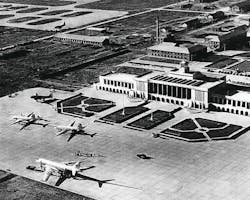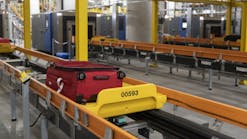Over the next few years, China plans to pump a quarter of a trillion dollars to turn itself into an aviation superpower. The country hosts more than two-thirds of the airports now under construction around the world with plans to expand 91 of 175 current facilities and to build 56 airports from the ground up.
Any description of the country’s plans will typically point straight up:
- According to the International Air Transport Association, 296 million passengers and 11 million metric tons of freight traveled to, within and from China on aircraft.
- Based on current trends, the domestic Chinese market alone for air travel is expected to double in size about every eight years.
- Beijing’s Capital International Airport is the second busiest in the world. But only about 15 million passengers separate it from the world’s busiest, Hartsfield-Jackson Atlanta International Airport.
- In 2010 the world’s three largest cargo airports were Hong Kong International; Memphis International (home to FedEx); and Shanghai Pudong International – with traffic up 20 percent from the year before at Hong Kong and Shanghai versus a 6 percent increase at Memphis.
- It will be the biggest growth market for Boeing and Airbus, though China is investing heavily in developing home-grown rivals in the hope of dominating the aviation markets of the 21st century.
But as expansive as China’s aviation market may seem, it’s still a veritable baby in the crib and starts out well behind the United States and the rest of the developed world:
- The country’s commercial airline fleet numbered about 2,600 in 2010, half as many as America’s number, but with a population four times as large.
- The United States has more 1,000 airports available for commercial aviation and 4,000 airports for general aviation and corporate jets. China, meanwhile, operates 175 airports and since, technically, the air space belongs to the military, it has limited general aviation or private jet traffic.
GSE IN CHINA
No matter how far behind they may start, the Chinese have a habit of catching up quickly and decidedly in its own particular fashion. When the government first began its economic reforms in 1980s, it did so with “Chinese characteristics,” meaning adopting Western business standards, but in a distinctly Chinese way.
To help us understand these characteristics for the Chinese aviation market in general and the GSE market in particular, we talked with Francis Chao, a Taiwanese-American consultant, who runs Uniworld, Pittsburg, CA. Chao business has been helping companies market products to Hong Kong, Taiwan and China since its start in 1970. For the past 20, however, Chao has been concentrating on China's aviation industry. He recently spoke about the industgry at our AviationPros LIVE event held last month in Las Vegas.
“Everything is happening very, very fast in China,” Chao says. “No one knows exactly what the Chinese are doing and they’re not talking.”
Chao’s been doing his part to find out what’s going on in China and to get people talking since the late-1990s when he sensed that the aviation market could soar in China.
At the time, Chao was working for the U.S. Department of Defense, FAA and other agencies as a contractor offering interpretation and other support services in dealing with Taiwan and China.
Chao initially put his energies into promoting general aviation in China and decided he could play a role fostering relationships between China’s emerging aviation industry with established commercial counterparts in the United States:
- In 1998, he published the first edition of the quarterly China Civil Aviation Report. “We started out just copying pages with an office copier,” he says. “And now it’s a full-color magazine.”
- In 2001, he started organizing an annual forum on general aviation that included Western industries and their Chinese counterparts to discussion aviation’s future in China.
- Also in 2001, he made his first trip to the Experimental Aircraft Association’s popular AirVenture show in Oshkosh, WI, escorting a delegation from the Civil Aviation Adminstration of China as part of an FAA project. He also produced and distributed 40,000 copies of a 130-page guide printed in Chinese called “What Is General Aviation?” In this case, Chao borrowed an idea from the General Aviation Manufacturers Association, which published a similar guide 40 years ago to promote general aviation in the United States.
Much of the promotion certainly had an impact. Earlier last year, the Chinese government announced that it would open up its skies – or at least that part that rises 1,000 meters above sea level – to general aviation.
As for commercial aviation, Chao says its overall capacity is currently only at 30 percent of America’s capacity.
“There are going to be a lot more airports,” he says, “and those airports are going to need a lot more equipment.”
We first met Chao in the pages of “China Airborne,” a book published last year by journalist and instrument-rated pilot James Fallows. In the book, Fallows chronicles China’s ambituous aviation plans and describes Chao as the consummate middleman who becomes an indespensible guide to anyone from the West looking to navigate Chinese culture and business.
“On one side are international companies large or small who sense that somehow that have to ‘get into’ China because of its vast potential,” writes Fallows in his book. “On the other side are the complexities, confusion and constant changes of customers and operating rules on the Chinese side.”
Our first thought was that electric equipment could be a trend for GSE in China, considering the recent headlines we’d read about how bad air pollution is in China. But Chao wouldn’t hear any of it.
“I read news about Chinese aviation all the time,” he says, “and some parts I may not agree with. But I never read anything about electric equipment whether by the government offering a subsidy to purchase it or through enacting regulations that it has to be used.”
And while air pollution is certainly a factor in the country’s large cities, the smog can’t be blamed on the country’s relatively small numbers of airports.
Chao reiterates much of what we’ve heard about the country’s politics – that growth is the main source of legitimacy for China’s current rulers.
“Buying electric GSE will not make anyone any money necessarily and everyone is only interested right now in buying equipment that will generate revenue,” Chao advises.
As for selling GSE with Chinese characteristics, Chao offered two broad strokes of advice:
- Partner Up: GSE is not so sophisticated that it can’t be – to use Chao’s choice of two words – “copied” or “borrowed.”
“Once the Chinese learn how to make something,” Chao explains, “it’s ‘Thank you very much, but we don’t need you any longer.’”
When Chao first began consulting, there was an imaginary line running somewhere between China and his clients, which were typically operating facilities anywhere, but inside China.
But as the country modernized and began moving past simply operating factories on Chinese soil for the export of low-cost consumer goods, the Chinese government began to put pressure on “outsiders” to operate in China. (For more on this, take a look at our editorial, “GSE Diplomacy,” on page 34.)
The pressure isn’t all political, of course.
“With a relatively small country like Taiwan,” Chao says, “you can make product elsewhere and sell it there. But China is such a large country geographically that it only makes economic sense to build or assemble in China when you factor in the extra cost of shipping, duty fees and other transaction costs of importing.”
- Be A Landlord: Land is “free” in China if only because the government owns and controls this resource. As a result, this free commodity becomes very valuable indeed.
Chao recommends that Western manufacturers claim some land without worrying too much about running a profitable venture – at least not initially.
“If you are going to wait until the market is developed for your product, it will be too late,” Chao says. “Someone will already be in front of you who has land to build a factory.”
And while the implications are unsavory, Chao also says that so keen is the government on growth that aviation is the only excuse for taking collectively owned land away from the owners – in plain English, that means kicking the farmer off his plot. And between 2006 and 2010, local authorities did just that opening up rural land amounting to the size of New Jersey to new development.
“Land is the most important thing,” he adds.




